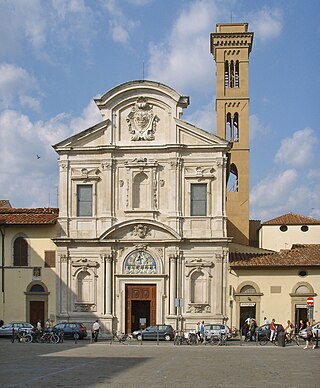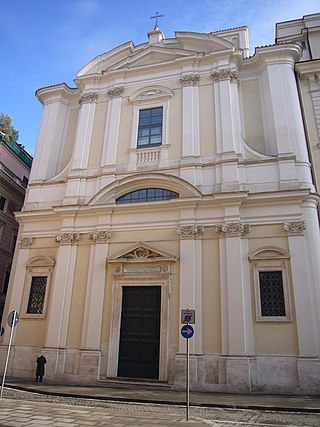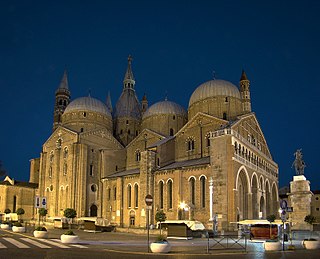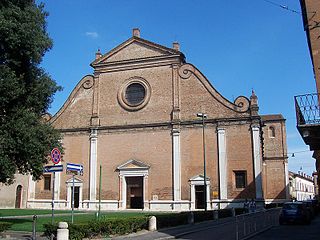
The Papal Basilica of Saint Peter in the Vatican, or simply Saint Peter's Basilica, is an Italian Renaissance and Baroque church located in Vatican City, an independent microstate enclaved within the city of Rome, Italy. It was initially planned in the 15th century by Pope Nicholas V and then Pope Julius II to replace the aging Old St. Peter's Basilica, which was built in the fourth century by Roman emperor Constantine the Great. Construction of the present basilica began on 18 April 1506 and was completed on 18 November 1626.

The Church of the Gesù is the mother church of the Society of Jesus (Jesuits), a Catholic religious order. Officially named Chiesa del Santissimo Nome di Gesù all'Argentina, its façade is "the first truly baroque façade", introducing the baroque style into architecture. The church served as a model for innumerable Jesuit churches all over the world, especially in the Americas. Its paintings in the nave, crossing, and side chapels became models for Jesuit churches throughout Italy and Europe, as well as those of other orders. The Church of the Gesù is located in the Piazza del Gesù in Rome.

The Basilica Papale di San Lorenzo fuori le mura is a Roman Catholic papal minor basilica and parish church, located in Rome, Italy. The Basilica is one of the Seven Pilgrim Churches of Rome and one of the five "papal basilicas", each of which was assigned to the care of a Latin Church patriarchate. The basilica was assigned to the Patriarchate of Jerusalem. The basilica is the shrine of the tomb of its namesake, Lawrence, one of the first seven deacons of Rome who was martyred in 258. Many other saints and Pope Pius IX are also buried at the Basilica, which is the centre of a large and ancient burial complex.

The Basilica of Saint Francis of Assisi is the mother church of the Roman Catholic Order of Friars Minor Conventual in Assisi, a town in the Umbria region in central Italy, where Saint Francis was born and died. It is a papal minor basilica and one of the most important places of Christian pilgrimage in Italy. With its accompanying friary, Sacro Convento, the basilica is a distinctive landmark to those approaching Assisi. It has been a UNESCO World Heritage Site since 2000.

The Basilica of San Petronio is a minor basilica and church of the Archdiocese of Bologna located in Bologna, Emilia Romagna, northern Italy. It dominates Piazza Maggiore. The basilica is dedicated to the patron saint of the city, Saint Petronius, who was the bishop of Bologna in the fifth century. Construction began in 1390 and its main facade has remained unfinished since. The building was transferred from the city to the diocese in 1929; the basilica was finally consecrated in 1954. It has been the seat of the relics of Bologna's patron saint only since 2000; until then they were preserved in the Santo Stefano church of Bologna.

The Basilica of Saint Mary of the Angels is a papal minor basilica situated in the plain at the foot of the hill of Assisi, Italy, in the frazione of Santa Maria degli Angeli.

The Basilica of San Domenico is one of the major churches in Bologna, Italy. The remains of Saint Dominic, founder of the Order of Preachers (Dominicans), are buried inside the exquisite shrine Arca di San Domenico, made by Nicola Pisano and his workshop, Arnolfo di Cambio and with later additions by Niccolò dell'Arca and the young Michelangelo.

Orvieto Cathedral is a large 14th-century Roman Catholic cathedral dedicated to the Assumption of the Virgin Mary and situated in the town of Orvieto in Umbria, central Italy. Since 1986, the cathedral in Orvieto has been the episcopal seat of the former Diocese of Todi as well.

The chiesa di San Salvatore di Ognissanti, or more simply chiesa di Ognissanti, is a Franciscan church located on the piazza of the same name in central Florence, region of Tuscany, Italy. Founded by the lay order of the Umiliati, the church was dedicated to all the saints and martyrs, known and unknown.

The Basilica di Sant'Apollinare alle Terme Neroniane-Alessandrine is a titular church in Rome, Italy, dedicated to St Apollinare, the first bishop of Ravenna.

The Pontifical Basilica of Saint Anthony of Padua is a Catholic church and minor basilica in Padua, Veneto, Northern Italy, dedicated to St. Anthony of Padua.

The Basilica della Santissima Annunziata del Vastato is the Catholic cathedral of Genoa, northern Italy; its decoration employed the major baroque studios and artists in Genoa in the 17th century.

The Basilica of San Domenico, also known as Basilica Cateriniana, is a basilica church in Siena, Tuscany, Italy, one of the most important in the city. The basilica is an example of Cistercian Gothic style.

The Basilica of Corpus Domini is a Roman Catholic church in Turin, Italy, built to celebrate the "Miracle of the Eucharist" which, according to various sources, occurred in 1453 during the war between the Duchy of Savoy and France.

The Ancient Royal and Eminent Basilica Collegiate of Our Lady of the Alms, better known as Basilica della Colleggiata, is a church in Catania, Sicily, southern Italy. Finished in 1794, it is an example of Sicilian Baroque.

The Basilica of St. Francis is a parish church and minor basilica in Viterbo, central Italy. The museological management of the church is run by the Polo Museale del Lazio.

San Francesco is a late-Renaissance, Roman Catholic minor basilica church located on via Terranuova in Ferrara, Emilia-Romagna, Italy.

Santa Caterina d'Alessandria or Saint Catherine of Alexandria is a Roman Catholic church with a main facade on Piazza Bellini, and a lateral Western facade facing the elaborate Fontana Pretoria, in the historic quarter of Kalsa in the city of Palermo, region of Sicily, Italy. In front of the main facade, across the piazza Bellini, rise the older churches of San Cataldo and Santa Maria dell'Ammiraglio, while across Piazza Pretoria is the Theatine church of San Giuseppe and the entrance to the Quattro Canti. Refurbished over the centuries, the church retains elements and decorations from the Renaissance, Baroque, and late-Baroque (Rococo) eras. This church is distinct from the Oratorio di Santa Caterina found in the Olivella neighborhood.

The Basilica of Santa Maria della Quercia is a Renaissance-style, Roman Catholic sanctuary church and minor basilica, about two kilometer outside of the center of Viterbo, on the road to Bagnaia, in the Region of Lazio, Italy.

Montalto Cathedral, otherwise the Basilica of Santa Maria Assunta e San Vito, is the principal Roman Catholic church of the town of Montalto delle Marche, province of Ascoli Piceno in the region of Le Marche, Italy. It is dedicated to the Assumption of the Virgin Mary. The church was formerly, from 1586, the episcopal seat of the Diocese of Montalto. When the diocese was subsumed into the present Diocese of San Benedetto del Tronto–Ripatransone–Montalto in 1986, Montalto Cathedral became a co-cathedral in the new diocese. It was created a basilica minor by Pope Paul VI in 1965.























